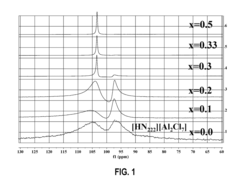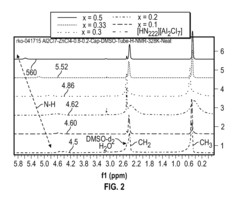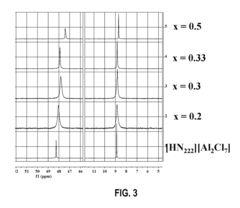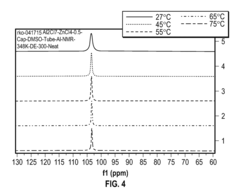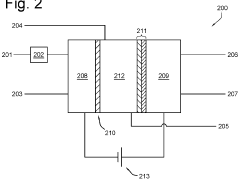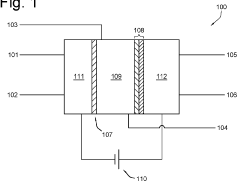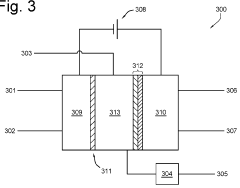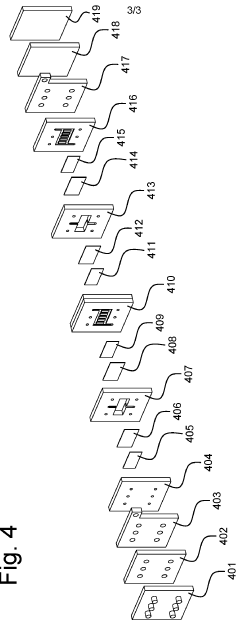Fluoroantimonic Acid: Paving the Future of Acid Catalysis
JUN 20, 20259 MIN READ
Generate Your Research Report Instantly with AI Agent
Patsnap Eureka helps you evaluate technical feasibility & market potential.
Fluoroantimonic Acid Evolution and Objectives
Fluoroantimonic acid, often hailed as the world's strongest superacid, has a rich history dating back to its discovery in the 1960s. This remarkable compound, formed by mixing hydrogen fluoride and antimony pentafluoride, has revolutionized the field of acid catalysis and continues to push the boundaries of chemical reactivity.
The evolution of fluoroantimonic acid research has been marked by significant milestones. Initially, its extreme acidity posed challenges in handling and application, limiting its use to specialized laboratory settings. However, as understanding of its properties grew, researchers began to explore its potential in various chemical processes, particularly in the petrochemical industry.
Throughout the 1980s and 1990s, advancements in containment materials and safety protocols enabled more extensive studies of fluoroantimonic acid. This period saw a surge in research focused on its catalytic properties, with scientists investigating its ability to facilitate reactions that were previously thought impossible or impractical.
The turn of the millennium brought renewed interest in fluoroantimonic acid as a tool for developing novel synthetic pathways. Its unparalleled proton-donating capacity opened up new possibilities in organic synthesis, particularly in the creation of complex molecules and the activation of traditionally unreactive compounds.
Recent years have witnessed a shift towards understanding the fundamental nature of superacidity and its implications for chemical bonding and reactivity. Researchers are now delving into the quantum mechanical aspects of fluoroantimonic acid's behavior, seeking to unravel the mysteries of its extreme acidity at the molecular level.
Looking ahead, the objectives for fluoroantimonic acid research are multifaceted. One primary goal is to harness its catalytic power more efficiently and safely, potentially revolutionizing industrial processes in the chemical and pharmaceutical sectors. There is also a push to develop more environmentally friendly applications, exploring ways to utilize its unique properties while minimizing ecological impact.
Another key objective is to expand the range of reactions that can be catalyzed by fluoroantimonic acid. This includes investigating its potential in asymmetric synthesis, where its extreme acidity could enable unprecedented levels of selectivity and control over reaction outcomes.
Furthermore, researchers aim to deepen our understanding of superacidity phenomena, using fluoroantimonic acid as a model system. This fundamental research could lead to the development of new superacids with tailored properties for specific applications, potentially opening up entirely new fields of chemistry.
The evolution of fluoroantimonic acid research has been marked by significant milestones. Initially, its extreme acidity posed challenges in handling and application, limiting its use to specialized laboratory settings. However, as understanding of its properties grew, researchers began to explore its potential in various chemical processes, particularly in the petrochemical industry.
Throughout the 1980s and 1990s, advancements in containment materials and safety protocols enabled more extensive studies of fluoroantimonic acid. This period saw a surge in research focused on its catalytic properties, with scientists investigating its ability to facilitate reactions that were previously thought impossible or impractical.
The turn of the millennium brought renewed interest in fluoroantimonic acid as a tool for developing novel synthetic pathways. Its unparalleled proton-donating capacity opened up new possibilities in organic synthesis, particularly in the creation of complex molecules and the activation of traditionally unreactive compounds.
Recent years have witnessed a shift towards understanding the fundamental nature of superacidity and its implications for chemical bonding and reactivity. Researchers are now delving into the quantum mechanical aspects of fluoroantimonic acid's behavior, seeking to unravel the mysteries of its extreme acidity at the molecular level.
Looking ahead, the objectives for fluoroantimonic acid research are multifaceted. One primary goal is to harness its catalytic power more efficiently and safely, potentially revolutionizing industrial processes in the chemical and pharmaceutical sectors. There is also a push to develop more environmentally friendly applications, exploring ways to utilize its unique properties while minimizing ecological impact.
Another key objective is to expand the range of reactions that can be catalyzed by fluoroantimonic acid. This includes investigating its potential in asymmetric synthesis, where its extreme acidity could enable unprecedented levels of selectivity and control over reaction outcomes.
Furthermore, researchers aim to deepen our understanding of superacidity phenomena, using fluoroantimonic acid as a model system. This fundamental research could lead to the development of new superacids with tailored properties for specific applications, potentially opening up entirely new fields of chemistry.
Market Demand Analysis for Superacid Catalysts
The market demand for superacid catalysts, particularly fluoroantimonic acid, has been steadily growing due to its exceptional catalytic properties and potential applications across various industries. The global superacid catalyst market is experiencing significant expansion, driven by the increasing need for efficient and environmentally friendly catalytic processes in chemical manufacturing, petrochemicals, and pharmaceuticals.
In the chemical manufacturing sector, fluoroantimonic acid has gained traction as a powerful catalyst for alkylation reactions, isomerization processes, and the production of high-octane gasoline components. The automotive industry's shift towards cleaner and more efficient fuels has further boosted the demand for superacid catalysts in refinery operations. Additionally, the growing emphasis on sustainable chemical processes has led to increased research and development efforts to utilize fluoroantimonic acid in green chemistry applications.
The pharmaceutical industry has also shown a rising interest in superacid catalysts, particularly for the synthesis of complex drug molecules. Fluoroantimonic acid's ability to catalyze challenging reactions under milder conditions offers significant advantages in terms of yield, selectivity, and overall process efficiency. This has led to a surge in demand from pharmaceutical companies looking to optimize their production processes and reduce manufacturing costs.
In the petrochemical sector, the demand for superacid catalysts has been driven by the need for more efficient cracking and isomerization processes in the production of high-value chemicals and fuels. Fluoroantimonic acid's exceptional acidity and catalytic activity make it an attractive option for these applications, potentially leading to improved product quality and reduced energy consumption.
The electronics industry has also emerged as a potential growth area for superacid catalysts. Fluoroantimonic acid's unique properties make it suitable for etching and surface modification processes in semiconductor manufacturing, potentially opening up new avenues for market expansion.
Despite the growing demand, challenges such as handling difficulties, safety concerns, and environmental considerations associated with fluoroantimonic acid have led to increased research efforts in developing safer and more sustainable superacid catalysts. This has created opportunities for innovation in catalyst design and formulation, potentially expanding the market for next-generation superacid catalysts.
As industries continue to prioritize efficiency, sustainability, and cost-effectiveness, the market demand for superacid catalysts is expected to maintain its upward trajectory. The ongoing research and development efforts aimed at addressing the limitations of current superacid catalysts, including fluoroantimonic acid, are likely to drive further market growth and diversification in the coming years.
In the chemical manufacturing sector, fluoroantimonic acid has gained traction as a powerful catalyst for alkylation reactions, isomerization processes, and the production of high-octane gasoline components. The automotive industry's shift towards cleaner and more efficient fuels has further boosted the demand for superacid catalysts in refinery operations. Additionally, the growing emphasis on sustainable chemical processes has led to increased research and development efforts to utilize fluoroantimonic acid in green chemistry applications.
The pharmaceutical industry has also shown a rising interest in superacid catalysts, particularly for the synthesis of complex drug molecules. Fluoroantimonic acid's ability to catalyze challenging reactions under milder conditions offers significant advantages in terms of yield, selectivity, and overall process efficiency. This has led to a surge in demand from pharmaceutical companies looking to optimize their production processes and reduce manufacturing costs.
In the petrochemical sector, the demand for superacid catalysts has been driven by the need for more efficient cracking and isomerization processes in the production of high-value chemicals and fuels. Fluoroantimonic acid's exceptional acidity and catalytic activity make it an attractive option for these applications, potentially leading to improved product quality and reduced energy consumption.
The electronics industry has also emerged as a potential growth area for superacid catalysts. Fluoroantimonic acid's unique properties make it suitable for etching and surface modification processes in semiconductor manufacturing, potentially opening up new avenues for market expansion.
Despite the growing demand, challenges such as handling difficulties, safety concerns, and environmental considerations associated with fluoroantimonic acid have led to increased research efforts in developing safer and more sustainable superacid catalysts. This has created opportunities for innovation in catalyst design and formulation, potentially expanding the market for next-generation superacid catalysts.
As industries continue to prioritize efficiency, sustainability, and cost-effectiveness, the market demand for superacid catalysts is expected to maintain its upward trajectory. The ongoing research and development efforts aimed at addressing the limitations of current superacid catalysts, including fluoroantimonic acid, are likely to drive further market growth and diversification in the coming years.
Current State and Challenges in Fluoroantimonic Acid Research
Fluoroantimonic acid, often hailed as the world's strongest superacid, has garnered significant attention in the field of acid catalysis. The current state of research in this area is characterized by both remarkable progress and formidable challenges. Globally, scientists have made substantial advancements in understanding the unique properties and potential applications of this powerful compound.
One of the primary areas of focus has been the synthesis and characterization of fluoroantimonic acid. Researchers have successfully developed methods to produce this superacid with high purity and stability, which is crucial for its practical application. However, the extreme reactivity of fluoroantimonic acid poses significant handling and storage challenges, requiring specialized equipment and safety protocols.
In terms of catalytic applications, fluoroantimonic acid has shown exceptional promise in various organic reactions, particularly in hydrocarbon chemistry. Its ability to protonate even weak bases and catalyze reactions under mild conditions has opened up new possibilities in synthetic organic chemistry. Nevertheless, the corrosive nature of the acid and its sensitivity to moisture remain significant hurdles in scaling up these processes for industrial use.
The geographical distribution of fluoroantimonic acid research is primarily concentrated in advanced research institutions and specialized chemical companies in North America, Europe, and East Asia. This concentration is largely due to the sophisticated infrastructure and expertise required to work with such a potent substance.
A major technical challenge in the field is the development of more stable and easily handled forms of fluoroantimonic acid. Some progress has been made in creating supported versions of the acid, which offer improved handling characteristics while maintaining high acidity. However, further research is needed to optimize these supported systems for broader applications.
Environmental and safety concerns present another significant challenge. The extreme reactivity of fluoroantimonic acid necessitates stringent safety measures, and its potential environmental impact is a subject of ongoing study. Researchers are actively exploring ways to mitigate these risks, including the development of containment systems and safer handling protocols.
Looking ahead, the field of fluoroantimonic acid research is poised for further innovation. Key areas of focus include the development of novel catalytic systems that harness the acid's unique properties while addressing its limitations, as well as the exploration of new applications in materials science and nanotechnology. The integration of computational methods and advanced characterization techniques is expected to play a crucial role in advancing our understanding and utilization of this remarkable superacid.
One of the primary areas of focus has been the synthesis and characterization of fluoroantimonic acid. Researchers have successfully developed methods to produce this superacid with high purity and stability, which is crucial for its practical application. However, the extreme reactivity of fluoroantimonic acid poses significant handling and storage challenges, requiring specialized equipment and safety protocols.
In terms of catalytic applications, fluoroantimonic acid has shown exceptional promise in various organic reactions, particularly in hydrocarbon chemistry. Its ability to protonate even weak bases and catalyze reactions under mild conditions has opened up new possibilities in synthetic organic chemistry. Nevertheless, the corrosive nature of the acid and its sensitivity to moisture remain significant hurdles in scaling up these processes for industrial use.
The geographical distribution of fluoroantimonic acid research is primarily concentrated in advanced research institutions and specialized chemical companies in North America, Europe, and East Asia. This concentration is largely due to the sophisticated infrastructure and expertise required to work with such a potent substance.
A major technical challenge in the field is the development of more stable and easily handled forms of fluoroantimonic acid. Some progress has been made in creating supported versions of the acid, which offer improved handling characteristics while maintaining high acidity. However, further research is needed to optimize these supported systems for broader applications.
Environmental and safety concerns present another significant challenge. The extreme reactivity of fluoroantimonic acid necessitates stringent safety measures, and its potential environmental impact is a subject of ongoing study. Researchers are actively exploring ways to mitigate these risks, including the development of containment systems and safer handling protocols.
Looking ahead, the field of fluoroantimonic acid research is poised for further innovation. Key areas of focus include the development of novel catalytic systems that harness the acid's unique properties while addressing its limitations, as well as the exploration of new applications in materials science and nanotechnology. The integration of computational methods and advanced characterization techniques is expected to play a crucial role in advancing our understanding and utilization of this remarkable superacid.
Existing Applications of Fluoroantimonic Acid
01 Fluoroantimonic acid as a catalyst in hydrocarbon processing
Fluoroantimonic acid is utilized as a powerful catalyst in various hydrocarbon processing applications, including isomerization, alkylation, and cracking reactions. Its super-acidic properties enable efficient conversion of hydrocarbons under milder conditions compared to traditional catalysts.- Fluoroantimonic acid as a catalyst in hydrocarbon processing: Fluoroantimonic acid is used as a powerful catalyst in various hydrocarbon processing applications, including isomerization, alkylation, and cracking reactions. Its super-acidic properties make it highly effective in promoting these reactions under milder conditions compared to traditional catalysts.
- Fluoroantimonic acid in polymer synthesis and modification: The catalytic properties of fluoroantimonic acid are utilized in polymer synthesis and modification processes. It can initiate polymerization reactions, facilitate polymer cross-linking, and enable the functionalization of existing polymers, leading to the development of new materials with enhanced properties.
- Application in organic synthesis and fine chemical production: Fluoroantimonic acid catalysis plays a crucial role in organic synthesis and the production of fine chemicals. Its strong acidity enables challenging transformations, such as C-C bond formation, rearrangements, and selective functionalization of complex molecules, which are valuable in pharmaceutical and agrochemical industries.
- Use in electrochemical applications and energy storage: Fluoroantimonic acid finds applications in electrochemical processes and energy storage technologies. It can be used as an electrolyte component in advanced batteries, fuel cells, and supercapacitors, potentially improving their performance and efficiency.
- Safety and handling considerations in fluoroantimonic acid catalysis: Due to its extreme acidity and reactivity, the use of fluoroantimonic acid in catalysis requires specialized safety measures and handling procedures. This includes the development of containment systems, neutralization protocols, and protective equipment to ensure safe and efficient utilization of this powerful catalyst in industrial processes.
02 Synthesis and preparation of fluoroantimonic acid
Methods for synthesizing and preparing fluoroantimonic acid are described, involving the reaction of hydrogen fluoride with antimony pentafluoride. Various techniques are employed to control the reaction conditions and ensure the purity of the resulting super-acid catalyst.Expand Specific Solutions03 Applications in polymer chemistry and materials science
Fluoroantimonic acid catalysis is applied in polymer chemistry and materials science for initiating polymerization reactions, modifying polymer structures, and developing advanced materials with unique properties. Its strong acidic nature enables efficient catalysis of various reactions in these fields.Expand Specific Solutions04 Use in organic synthesis and pharmaceutical production
Fluoroantimonic acid serves as a catalyst in organic synthesis reactions and pharmaceutical production processes. Its super-acidic properties enable the formation of complex organic molecules and intermediates used in drug synthesis under mild conditions.Expand Specific Solutions05 Safety and handling considerations for fluoroantimonic acid
Due to its highly corrosive and reactive nature, special safety measures and handling procedures are required when working with fluoroantimonic acid. This includes the use of specialized equipment, containment systems, and protective gear to ensure safe handling and storage of the super-acid catalyst.Expand Specific Solutions
Key Players in Superacid Catalyst Industry
The field of Fluoroantimonic Acid catalysis is in its early growth stage, with significant potential for expansion. The market size is relatively small but growing rapidly as industries recognize its catalytic power. Technologically, it's still evolving, with varying levels of maturity across applications. Key players like Centre National de la Recherche Scientifique, Zhejiang University, and Yale University are driving academic research, while companies such as 3M Innovative Properties Co., DuPont de Nemours, Inc., and BASF Corp. are focusing on industrial applications. The competitive landscape is characterized by a mix of academic institutions and chemical industry giants, each contributing to the advancement of this powerful superacid's applications in catalysis.
Centre National de la Recherche Scientifique
Technical Solution: The Centre National de la Recherche Scientifique (CNRS) has been at the forefront of research on fluoroantimonic acid catalysis. Their approach involves the development of novel synthetic methodologies using fluoroantimonic acid as a superacid catalyst. They have successfully applied this in the synthesis of complex organic molecules, particularly in the field of pharmaceutical intermediates. The CNRS team has also focused on understanding the mechanistic aspects of fluoroantimonic acid-catalyzed reactions, which has led to the design of more efficient and selective catalytic systems.
Strengths: Cutting-edge research in superacid catalysis, deep understanding of reaction mechanisms, and application in pharmaceutical synthesis. Weaknesses: High cost of fluoroantimonic acid, safety concerns in handling, and potential environmental impact.
DuPont de Nemours, Inc.
Technical Solution: DuPont has developed a proprietary fluoroantimonic acid-based catalytic system for the production of high-performance polymers and specialty chemicals. Their technology focuses on utilizing the superacidic properties of fluoroantimonic acid in controlled environments to achieve highly efficient and selective chemical transformations. DuPont's approach includes the use of specially designed reactors and handling systems to mitigate the corrosive nature of the acid. They have successfully applied this technology in the synthesis of fluoropolymers with unique properties, as well as in the production of advanced materials for electronics and aerospace applications.
Strengths: Industrial-scale application, specialized equipment for safe handling, and production of high-value materials. Weaknesses: High initial investment costs, limited applicability outside specific product lines, and potential regulatory challenges.
Core Innovations in Fluoroantimonic Acid Synthesis
Mixed metal double salt ionic liquids with tunable acidity
PatentInactiveUS20170209858A1
Innovation
- Development of mixed metal double salt ionic liquids with tunable acidity, comprising at least one organic cation and two metal halide anions, which can be used as catalysts for acid-catalyzed reactions, including Friedel Crafts alkylation and biodiesel production, with a melting point below 150°C, allowing for recyclability and improved safety.
Electrochemical carbon dioxide reduction to formic acid
PatentWO2024146821A1
Innovation
- An electrolytic device with an anion exchange membrane on the cathode side and a bipolar membrane on the anode side, using an alkaline anolyte, which allows for the direct conversion of CO2 to formic acid with high purity and concentration, minimizing the need for acidification and reducing anolyte consumption, while employing cheap metal catalysts and improving water management.
Safety and Handling Protocols for Superacids
Fluoroantimonic acid, as one of the strongest known superacids, requires exceptional care and stringent safety protocols for handling and storage. The extreme corrosiveness and reactivity of this compound necessitate specialized equipment and facilities designed to withstand its potent nature. All personnel working with fluoroantimonic acid must undergo comprehensive training in superacid handling and emergency procedures.
Personal protective equipment (PPE) is paramount when working with fluoroantimonic acid. This includes chemical-resistant suits made from materials such as Teflon or Viton, along with face shields, goggles, and gloves rated for superacid exposure. Respiratory protection with appropriate filters is essential to prevent inhalation of any vapors or aerosols.
Storage of fluoroantimonic acid demands specially designed containers made from materials resistant to its corrosive properties, such as polytetrafluoroethylene (PTFE) or perfluoroalkoxy alkanes (PFA). These containers must be kept in secured, well-ventilated areas with controlled temperature and humidity. Regular inspections of storage facilities and containers are crucial to detect any signs of degradation or potential leaks.
Transportation of fluoroantimonic acid requires adherence to strict regulations for hazardous materials. Specialized transport containers with multiple layers of protection and appropriate labeling are mandatory. Emergency response plans must be in place, and personnel involved in transportation should be trained in spill containment and neutralization procedures.
Laboratory work involving fluoroantimonic acid should be conducted in dedicated fume hoods with acid-resistant linings and proper ventilation systems. All equipment coming into contact with the acid must be thoroughly cleaned and neutralized after use. Waste disposal protocols for fluoroantimonic acid and related materials must comply with environmental regulations and typically involve careful neutralization before disposal.
Emergency response procedures for fluoroantimonic acid incidents are critical. This includes having readily accessible eyewash stations, safety showers, and spill kits designed for superacid containment. Neutralizing agents, such as sodium bicarbonate or calcium carbonate, should be available in sufficient quantities. Regular emergency drills and simulations help ensure that all personnel are prepared to respond swiftly and effectively to potential accidents.
Continuous monitoring of air quality in areas where fluoroantimonic acid is used or stored is essential to detect any leaks or emissions. Advanced detection systems capable of identifying trace amounts of fluoride or antimony compounds can provide early warnings of potential hazards. Regular health monitoring of personnel working with fluoroantimonic acid is also crucial to detect any signs of exposure or long-term health effects.
Personal protective equipment (PPE) is paramount when working with fluoroantimonic acid. This includes chemical-resistant suits made from materials such as Teflon or Viton, along with face shields, goggles, and gloves rated for superacid exposure. Respiratory protection with appropriate filters is essential to prevent inhalation of any vapors or aerosols.
Storage of fluoroantimonic acid demands specially designed containers made from materials resistant to its corrosive properties, such as polytetrafluoroethylene (PTFE) or perfluoroalkoxy alkanes (PFA). These containers must be kept in secured, well-ventilated areas with controlled temperature and humidity. Regular inspections of storage facilities and containers are crucial to detect any signs of degradation or potential leaks.
Transportation of fluoroantimonic acid requires adherence to strict regulations for hazardous materials. Specialized transport containers with multiple layers of protection and appropriate labeling are mandatory. Emergency response plans must be in place, and personnel involved in transportation should be trained in spill containment and neutralization procedures.
Laboratory work involving fluoroantimonic acid should be conducted in dedicated fume hoods with acid-resistant linings and proper ventilation systems. All equipment coming into contact with the acid must be thoroughly cleaned and neutralized after use. Waste disposal protocols for fluoroantimonic acid and related materials must comply with environmental regulations and typically involve careful neutralization before disposal.
Emergency response procedures for fluoroantimonic acid incidents are critical. This includes having readily accessible eyewash stations, safety showers, and spill kits designed for superacid containment. Neutralizing agents, such as sodium bicarbonate or calcium carbonate, should be available in sufficient quantities. Regular emergency drills and simulations help ensure that all personnel are prepared to respond swiftly and effectively to potential accidents.
Continuous monitoring of air quality in areas where fluoroantimonic acid is used or stored is essential to detect any leaks or emissions. Advanced detection systems capable of identifying trace amounts of fluoride or antimony compounds can provide early warnings of potential hazards. Regular health monitoring of personnel working with fluoroantimonic acid is also crucial to detect any signs of exposure or long-term health effects.
Environmental Impact Assessment of Fluoroantimonic Acid Use
The environmental impact assessment of fluoroantimonic acid use is a critical consideration in its application as a catalyst in various industrial processes. Fluoroantimonic acid, known as the world's strongest superacid, poses significant environmental risks due to its extreme corrosiveness and reactivity.
One of the primary environmental concerns is the potential for accidental releases or spills. Given its highly corrosive nature, even small quantities of fluoroantimonic acid can cause severe damage to ecosystems. It can rapidly degrade organic matter, disrupt soil chemistry, and contaminate water sources, leading to long-term ecological imbalances.
Air pollution is another significant issue associated with fluoroantimonic acid use. The acid can release harmful fluorine and antimony compounds into the atmosphere, contributing to air quality degradation. These emissions may lead to the formation of acid rain, further impacting terrestrial and aquatic ecosystems far beyond the immediate area of use.
Water contamination is a severe risk, as fluoroantimonic acid can react violently with water, producing toxic and corrosive by-products. This reaction not only poses immediate dangers but can also lead to long-term contamination of groundwater and surface water bodies, affecting aquatic life and potentially entering the food chain.
The production and disposal of fluoroantimonic acid also present environmental challenges. The manufacturing process involves hazardous materials and energy-intensive procedures, contributing to carbon emissions and resource depletion. Proper disposal is crucial, as improper handling can lead to environmental contamination and pose risks to human health.
To mitigate these environmental impacts, stringent safety protocols and containment measures are essential in facilities using fluoroantimonic acid. Advanced treatment systems for emissions and effluents must be implemented to minimize the release of harmful substances into the environment. Additionally, research into less environmentally harmful alternatives or process optimizations that reduce the required quantities of the acid should be prioritized.
Regulatory bodies play a crucial role in overseeing the use of fluoroantimonic acid. Strict environmental impact assessments, regular monitoring, and enforcement of safety standards are necessary to ensure responsible use and minimize ecological risks. Companies utilizing this superacid must invest in comprehensive environmental management systems and emergency response plans to address potential incidents promptly and effectively.
In conclusion, while fluoroantimonic acid offers significant catalytic benefits in various industrial applications, its environmental impact cannot be overlooked. Balancing its technological advantages with ecological preservation requires ongoing research, innovative safety measures, and a commitment to sustainable practices in its production, use, and disposal.
One of the primary environmental concerns is the potential for accidental releases or spills. Given its highly corrosive nature, even small quantities of fluoroantimonic acid can cause severe damage to ecosystems. It can rapidly degrade organic matter, disrupt soil chemistry, and contaminate water sources, leading to long-term ecological imbalances.
Air pollution is another significant issue associated with fluoroantimonic acid use. The acid can release harmful fluorine and antimony compounds into the atmosphere, contributing to air quality degradation. These emissions may lead to the formation of acid rain, further impacting terrestrial and aquatic ecosystems far beyond the immediate area of use.
Water contamination is a severe risk, as fluoroantimonic acid can react violently with water, producing toxic and corrosive by-products. This reaction not only poses immediate dangers but can also lead to long-term contamination of groundwater and surface water bodies, affecting aquatic life and potentially entering the food chain.
The production and disposal of fluoroantimonic acid also present environmental challenges. The manufacturing process involves hazardous materials and energy-intensive procedures, contributing to carbon emissions and resource depletion. Proper disposal is crucial, as improper handling can lead to environmental contamination and pose risks to human health.
To mitigate these environmental impacts, stringent safety protocols and containment measures are essential in facilities using fluoroantimonic acid. Advanced treatment systems for emissions and effluents must be implemented to minimize the release of harmful substances into the environment. Additionally, research into less environmentally harmful alternatives or process optimizations that reduce the required quantities of the acid should be prioritized.
Regulatory bodies play a crucial role in overseeing the use of fluoroantimonic acid. Strict environmental impact assessments, regular monitoring, and enforcement of safety standards are necessary to ensure responsible use and minimize ecological risks. Companies utilizing this superacid must invest in comprehensive environmental management systems and emergency response plans to address potential incidents promptly and effectively.
In conclusion, while fluoroantimonic acid offers significant catalytic benefits in various industrial applications, its environmental impact cannot be overlooked. Balancing its technological advantages with ecological preservation requires ongoing research, innovative safety measures, and a commitment to sustainable practices in its production, use, and disposal.
Unlock deeper insights with Patsnap Eureka Quick Research — get a full tech report to explore trends and direct your research. Try now!
Generate Your Research Report Instantly with AI Agent
Supercharge your innovation with Patsnap Eureka AI Agent Platform!
